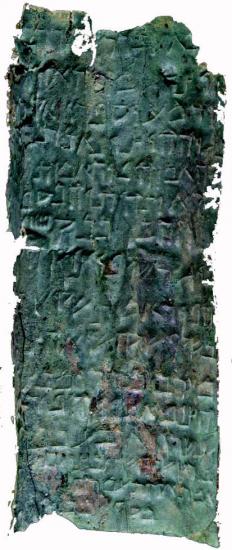Hebrew pseudo-historical text is fully translated in English for the first time
Source -http://www.archaiologia.gr/en/blog/2014/01/10/where-is-the-ark-of-the-covenant/

The Copper Scroll, with text bearing content similarities to the "Treatise of the Vessels". c. 70 AD. The Jordan Museum, Amman, Jordan.
“[It] shall not be revealed until the day of the coming of the Messiah son of David …” . This is what a newly translated Hebrew text reveals on the whereabouts of the famous Ark of the Covenant, where the Israelites kept the plaques inscribed with the Ten Commandments and other “memorabilia”-evidence of God’s presence- of their wandering around the desert, after fleeing Egypt to reach the promiseland. According to the Bible, the Israelites made the Ark soon after Moses came with the Commandments, and kept it initially in a Tabernacle and ultimately in King Solomon’s Temple.
The text, called “Treatise of the Vessels” (Massekhet Kelim in Hebrew), refers to the Ark as well as other treasures kept in the Temple and lost when the building complex was plundered and torched by the Babylonian King Nebuchadnezzar II in the 6th century BC. Here, the Temple’s treasures are described quite imaginative. “Seventy-seven tables of gold, and their gold was from the walls of the Garden of Eden that was revealed to Solomon, and they radiated like the radiance of the sun and moon, which radiate at the height of the world.”, states the text in an exemplary passage. As a litterary form, the tretise is similar in some ways to the metallic “Copper Scroll,” (one of the Dead Sea Scrolls found near the site of Qumran in the West Bank), which also discusses the location of hidden treasure, although not from Solomon’s Temple.
The “treasures were concealed by a number of Levites and prophets.[...] Some of these (treasures) were hidden in various locations in the Land of Israel and in Babylonia, while others were delivered into the hands of the angels Shamshiel, Michael, Gabriel and perhaps Sariel …” writes James Davila in an article in the book “Old Testament Pseudepigrapha More Noncanonical Scriptures Volume 1″ (William B. Eerdmans Publishing Co., 2013).
A professor at the University of St. Andrews, Davila is the first to fully translate the known text into English. The oldest confirmed example of the treatise, which survives to present day, is from a book published in Amsterdam in 1648 called “Emek Halachah.” In 1876, a scholar named Adolph Jellinek published another copy of the text, which was virtually identical to the 1648 version.
The study of the treatise was proved ongoing, and discoveries continued to be made. In the mid-20th century a copy of it (with some variations) was discovered and recorded in Beirut, Lebanon, at the end of a series of inscribed plates that record the Book of Ezekiel. Those plates are now at the Yad Ben Zvi Institute in Israel, although the plates containing the treatise itself are now missing. Recent research has revealed these plates were created in Syria at the turn of the 20th century, about 100 years ago, suggesting the treatise was being told in an elaborate way up until relatively modern times.
According to Davila, the writer of the original text was not trying to convey factual locations of the hidden treasures of Solomon’s Temple, but rather was writing a work of fiction, based on different legends. His work was to be ”a piece of entertaining fiction, not any kind of real guide for finding the lost Temple treasures,”he says.
As for the similarities with the Copper Scroll, both texts refer to “vessels” or “implements,” including examples made of gold and silver -a matter of potential coincidence, tradition or reporting important info on metal, as it is more durable than parchment of papyrus, which were commonly used as writing material for records.
“My guess is that whoever wrote the Treatise of Vessels came up with the same idea [of writing a treasure list on metal] coincidentally on their own, although it is not unthinkable that the writer knew of some ancient tradition or custom about inscribing important information on metal”, Davila states.